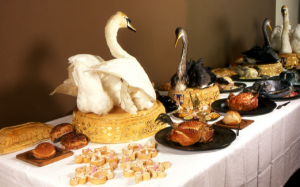If you do not know of Ben Jonson, well you should. As a poet in the 1600’s during the Renaissance era in England, he put a twist on his writing. You would find detail visions lurking within his writings of the food that was placed before him. I mean, who doesn’t love a good meal – am I right?
Ben Jonson was born into poverty in 1572. His father died before he was born and his stepfather was a bricklayer. After deciding to trade in his education to follow in his stepfather’s footsteps, that as well as his education ended when he decided to fight with English forces. One could easily think this may be a cause for his slight obsession with food. From the poem Inviting a Friend to Supper to To Penshurst we see detail images of the food. Again, who doesn’t love a good meal, yet, who sits down at night to write in their diary about their day and writes a page and a half on one meal? I’m not too sure. Maybe that’s why it is called a diary. Anyways, I digress.
Some examples of what Jonson was trying to portray to his reader goes a little like this:
“Bright eels that emulate them, and leap on land
Before the fisher, or into his hand.
Then hath thy orchard fruit, thy garden flowers,
Fresh as the air, and new as are the hours.
The early cherry, with the later plum,
Fig, grape, and quince, each in his time doth come;
The blushing apricot and woolly peach
Hang on thy walls, that every child may reach.”
–To Penshurst
I’m sorry, but I have never read something so passionate about food. This is almost a love letter to food if you look at it that way. He is going on and on about how wonderful every bit of this meal is and is going to be.
“A waiter doth my gluttony envy,
But gives me what I call, and lets me eat;
He knows below he shall find plenty of meat.”
–To Penshurst
One thing that I found to be completely thought provoking was Jonson’s use of the waiter within the poem. Apparently, the waiters serving for the wealthier people would get their meal from the leftovers after the feast or party. So, it is easy to say that then Jonson rolled up in there the waiters might be a little distressed by his size. Yet, within To Penshurst Jonson is explaining that the waiter does not even care how much Jonson wants to eat because it is so luxurious that there is going to be more and the servants won’t go hungry. They will indeed get their meal.
So, what the heck did the food that Jonson was looking at actually look like? I am almost positive it did not come prepackaged in a Chick-fil-a container or a happy meal box like we are so accustomed to today.
The wealthy people during the Renaissance would obviously eat better than those of the lower classes. The wealthy and nobles definitely enjoyed having huge feasts with lots of fancy dishes. This was also a way of showing off their wealth to their friends in a sense. Like the peasants and lower classes, the wealthier class ate soups and broths, but these soups were spiced with exotic spices and often sweetened with sugar, this part was not as easy for those of lower classes to obtain. The rich ate more meat, duh. A huge sign of wealth was what meat you were eating. It showed that you had the means to go out and hunt or have someone hunt for you, OR you actually had the money to purchase said meat. They would have large roasts of beef, stag, or pig. What is probably the most interesting thing about the meat was that it would be visual as well. Most of the time, the center piece of the table would be a pig or other meats of sorts displayed in a grand way. You know how the pig would have an apple in its mouth in the center of the table? Yeah, think of that.
At weddings, festivals, and large feasts the food could get interesting (more interesting than pigs with apples in their mouths? No way!). Often, considering we are still talking about those with wealth, they would eat large game birds like swans, peacocks, or cranes; these meats would also be displayed in beautiful and wondrous ways as stated before. After cleaning and cooking the birds, they would often reattach the feathers for decoration. Have you ever watched The Tudors? If not, shame on you. If yes, continue reading. Remember when Henry VIII gives his French frienemy Francis I a gift of food? Think of this for feasts. (SPOILER ALERT: freaking BIRDS fly out of this pastry!! How sick is that?) Also, another cool thing to visualize in the Tudors, is when Henry is eating the swan. Very similar to what we are talking about here. This was also a time for lots of meat to be eaten such as mutton, chicken, pheasant, venison, rabbit, turkey, and ham.
Links:
https://www.poetryfoundation.org/poems-and-poets/poets/detail/ben-jonson#poet
http://writersinspire.org/content/ben-jonson-renaissance-playwright-renaissance-man
https://www.britannica.com/biography/Ben-Jonson-English-writer



